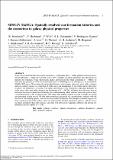Files in this item
SDSS-IV MaNGA : spatially resolved star-formation histories and the connection to galaxy physical properties
Item metadata
| dc.contributor.author | Rowlands, K. | |
| dc.contributor.author | Heckman, T. | |
| dc.contributor.author | Wild, V. | |
| dc.contributor.author | Zakamska, N. L. | |
| dc.contributor.author | Rodriguez-Gomez, V. | |
| dc.contributor.author | Barrera-Ballesteros, J. | |
| dc.contributor.author | Lotz, J. | |
| dc.contributor.author | Thilker, D. | |
| dc.contributor.author | Andrews, B. H. | |
| dc.contributor.author | Boquien, M. | |
| dc.contributor.author | Brinkmann, J. | |
| dc.contributor.author | Brownstein, J. R. | |
| dc.contributor.author | Hwang, H-C. | |
| dc.contributor.author | Smethurst, R. | |
| dc.date.accessioned | 2018-07-23T15:30:07Z | |
| dc.date.available | 2018-07-23T15:30:07Z | |
| dc.date.issued | 2018-07-19 | |
| dc.identifier | 255012099 | |
| dc.identifier | c6e0a11c-e6d8-490b-afc3-c4d6691962a4 | |
| dc.identifier | 85055196706 | |
| dc.identifier | 000449614800086 | |
| dc.identifier.citation | Rowlands , K , Heckman , T , Wild , V , Zakamska , N L , Rodriguez-Gomez , V , Barrera-Ballesteros , J , Lotz , J , Thilker , D , Andrews , B H , Boquien , M , Brinkmann , J , Brownstein , J R , Hwang , H-C & Smethurst , R 2018 , ' SDSS-IV MaNGA : spatially resolved star-formation histories and the connection to galaxy physical properties ' , Monthly Notices of the Royal Astronomical Society , vol. Advance article . https://doi.org/10.1093/mnras/sty1916 | en |
| dc.identifier.issn | 0035-8711 | |
| dc.identifier.other | BibCode: 2018arXiv180706066R | |
| dc.identifier.uri | https://hdl.handle.net/10023/15661 | |
| dc.description | Funding: V. W. acknowledges support from the European Research Council Starting Grant SEDmorph (P.I. V. Wild). | en |
| dc.description.abstract | A key task of observational extragalactic astronomy is to determine where – within galaxies of diverse masses and morphologies – stellar mass growth occurs, how it depends on galaxy properties and what processes regulate star formation. Using spectroscopic indices derived from the stellar continuum at ∼4000Å, we determine the spatially resolved star-formation histories of 980000 spaxels in 2404 galaxies in the SDSS-IV MaNGA IFU survey. We examine the spatial distribution of star-forming, quiescent, green valley, starburst and post-starburst spaxels as a function of stellar mass and morphology to see where and in what types of galaxy star formation is occurring. The spatial distribution of star-formation is dependent primarily on stellar mass, with a noticeable change in the distribution at M*>1010M⊙. Galaxies above this mass have an increasing fraction of regions that are forming stars with increasing radius, whereas lower mass galaxies have a constant fraction of star forming regions with radius. Our findings support a picture of inside-out growth and quenching at high masses. We find that morphology (measured via concentration) correlates with the fraction of star-forming spaxels, but not with their radial distribution. We find (post-)starburst regions are more common outside of the galaxy centre, are preferentially found in asymmetric galaxies, and have lower gas-phase metallicity than other regions, consistent with interactions triggering starbursts and driving low metallicity gas into regions at <1.5Re. | |
| dc.format.extent | 2180209 | |
| dc.language.iso | eng | |
| dc.relation.ispartof | Monthly Notices of the Royal Astronomical Society | en |
| dc.subject | Galaxies: evolution | en |
| dc.subject | Galaxies: interactions | en |
| dc.subject | Galaxies: abundances | en |
| dc.subject | Galaxies: ISM | en |
| dc.subject | Galaxies: starburst | en |
| dc.subject | QB Astronomy | en |
| dc.subject | QC Physics | en |
| dc.subject | 3rd-DAS | en |
| dc.subject.lcc | QB | en |
| dc.subject.lcc | QC | en |
| dc.title | SDSS-IV MaNGA : spatially resolved star-formation histories and the connection to galaxy physical properties | en |
| dc.type | Journal article | en |
| dc.contributor.sponsor | European Research Council | en |
| dc.contributor.institution | University of St Andrews. School of Physics and Astronomy | en |
| dc.identifier.doi | 10.1093/mnras/sty1916 | |
| dc.description.status | Peer reviewed | en |
| dc.identifier.url | http://adsabs.harvard.edu/abs/2018arXiv180706066R | en |
| dc.identifier.grantnumber | ERC-2012-StG-20111012 | en |
This item appears in the following Collection(s)
Items in the St Andrews Research Repository are protected by copyright, with all rights reserved, unless otherwise indicated.

